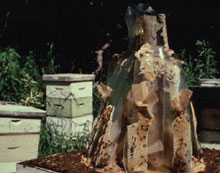Art by one woman and a million bees


Above: Bees at work on glass dress. Below, beeswax-caked skates.
Listening to Aganetha Dyck speak of her art as a collaborative effort with honeybees, it's easy to see what the buzz is about.
This multimedia artist, who comes from a rural Mennonite community in Manitoba, places inspired objects – a pair of skates, a glass-blown dress, and even short units, or cells, of poetry in Braille – into beehives, to let the bees add their own cells.
The result is wax and honeycomb projects that are the products of millions of collaborators. As the bees only produce during July and August, much of the work takes years to accomplish.
During this time, Dyck removes the items to shape and sculpt, often adding artwork to the surfaces. Her ink drawings are reproductions of hive-scanning photography of her son, Richard Dyck.
She describes the experience as "all-encompassing and warm, surrounded by wonderful smells."
Not limited to the artistic side of the process, Dyck also goes to great pains to ensure the safety of the bees in her apiary. In fact, she told her audience that the world's bee population has been reduced to five per cent of what it once was; it has only been preserved from extinction by beekeepers around the world.
Dyck, whose career as an artist started as a weaver's apprentice, has been working with honeybees for 14 years. She is preoccupied with the ways that knowledge is exchanged between humans and other species.
Her research has included the bee's use of sound, sight, scent, vibration, and dance. She’s studying the bee's use of the earth's magnetic fields, as well as their use of the pheromones they produce to communicate with one another. In fact, she is now using pheromone extracts from the bees themselves to draw guides for her buzzing friends to create along.
Dyck has done residencies in the Netherlands, Britain, and France. The work can take years due to a short summer beekeeping season of seven to nine weeks.
"I spend the rest of the year researching, travelling, and preparing work for the next beekeeping season," she said.
Dyck spoke at the Bourget Gallery on Jan. 21 as a part of the Artists Speakers Series sponsored by the Faculty of Fine Arts.